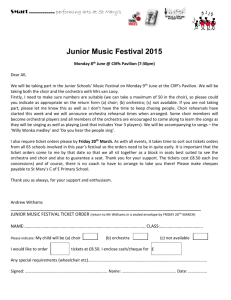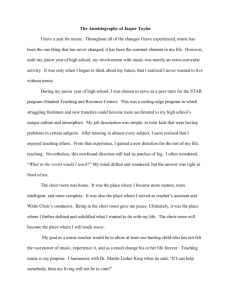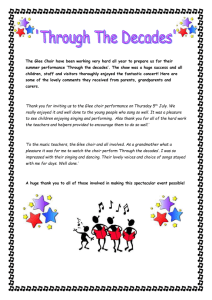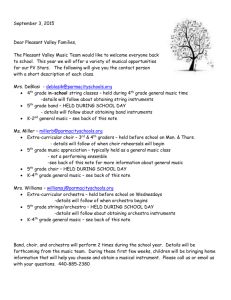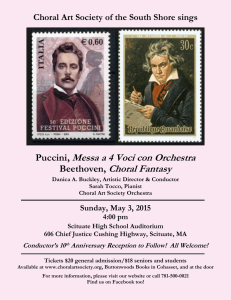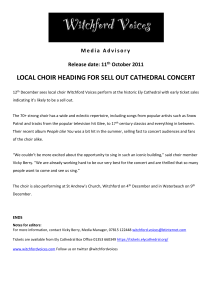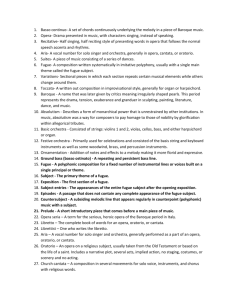AOS 2 great choral classics
advertisement
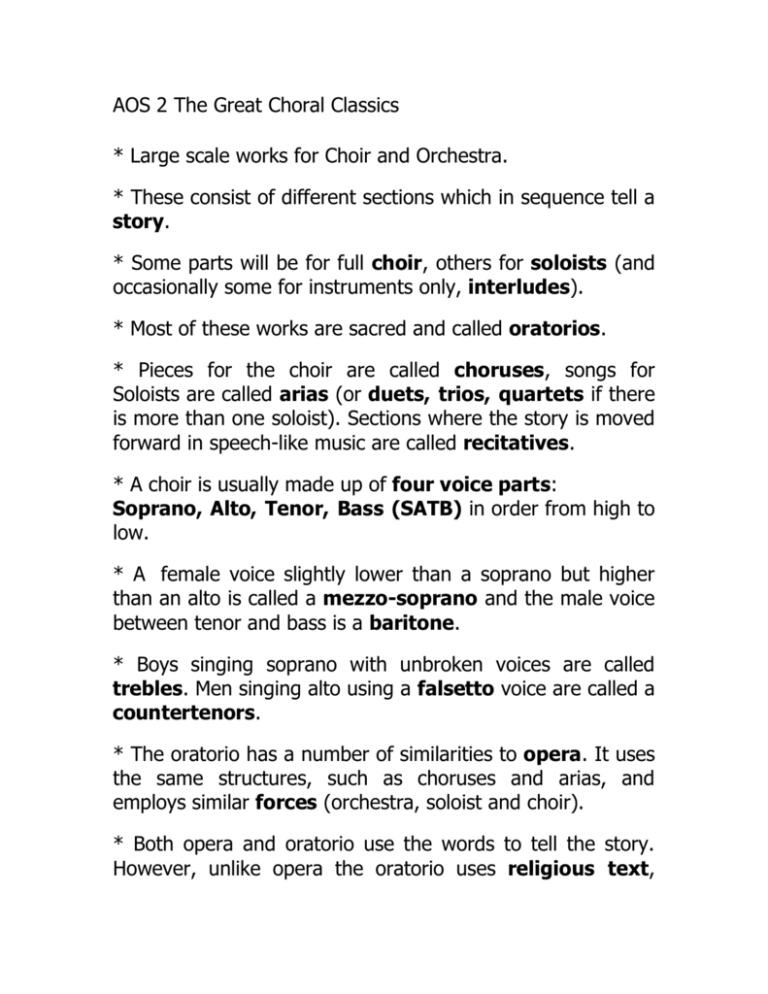
AOS 2 The Great Choral Classics * Large scale works for Choir and Orchestra. * These consist of different sections which in sequence tell a story. * Some parts will be for full choir, others for soloists (and occasionally some for instruments only, interludes). * Most of these works are sacred and called oratorios. * Pieces for the choir are called choruses, songs for Soloists are called arias (or duets, trios, quartets if there is more than one soloist). Sections where the story is moved forward in speech-like music are called recitatives. * A choir is usually made up of four voice parts: Soprano, Alto, Tenor, Bass (SATB) in order from high to low. * A female voice slightly lower than a soprano but higher than an alto is called a mezzo-soprano and the male voice between tenor and bass is a baritone. * Boys singing soprano with unbroken voices are called trebles. Men singing alto using a falsetto voice are called a countertenors. * The oratorio has a number of similarities to opera. It uses the same structures, such as choruses and arias, and employs similar forces (orchestra, soloist and choir). * Both opera and oratorio use the words to tell the story. However, unlike opera the oratorio uses religious text, which makes it suitable for performance in churches and cathedrals, where as opera is usually performed in theatres. * The oratorio is not as theatrical as opera, and is generally performed without acting, scenery or costumes. * A Mass is a choral work is based on Latin texts from the catholic communion service. Most masses consist of six movements (Kyrie, Gloria, Credo, Sanctus, Benedictus and Agnus Gei). The texts are of repentance, praise and belief. * Mass settings are different from other oratorios in that they are almost always in Latin, while most oratorios are in the language of the intended audience. For example, Handel composed the Italian oratorio La Resurrezione when living in Italy and the English oratorio Messiah after he moved to England. * A Requiem Mass is a “Mass for the dead”, used to honour the deceased and is often heard in a funeral context. It omits the more joyful movements of the ordinary Mass and adds in others such as the Dies Irae (“Day of Wrath”). * The Dies Irae describes the terror felt when standing before God at The Last Judgement. Verdi, who composed many operas, wrote a particularly dramatic Dies Irae in his setting of the Requiem. * The vocal forces created with large 4 part choirs (SATB) is very impressive. Choirs will sing in unison or in harmony, sometimes overlapping. * The texture (layers of sound) can change frequently within the same piece. * Homophonic texture - the choir sings in harmony at different pitches, this can be chordal or have a melody and accompaniment. * Polyphonic texture - the sections of the choir overlap, there can be several melodies at once. This type of texture can sound complex. Polyphony (Polyphonic texture) can also be referred to as Counterpoint (Contrapuntal texture). * Call and response is used where sections within the choir share a dialogue, at other times imitation is used. * The choir will usually follow a conductor. This helps all of the sections to stay in time and balance the dynamics. * Choral works are usually written for choir and orchestra. Sometimes a church organ may be used in addition to the orchestra. * Soloists are often included in choral music. As well as solo arias for an individual to sing with the orchestra, the soloist may have solo lines to sing with the chorus. * When all of the singers and orchestra work together this is called tutti (all together). * In opera singers memorise the lyrics. In Oratorios and Masses singers use a written vocal score. A vocal score will have all of the singers music as well as a piano part which is a condensed version of the orchestra music. * The Messiah by Handel is perhaps the most well known Oratorio. The Requiem Masses by Mozart and Verdi are also famous works within this genre. * Word painting is typically used by composers to emphasise certain words or meanings. Higher or rising pitches can be used to represent words such as God, Lord or Praise. Low pitches would be used for Hell. * Most words are sung with one note per syllable (syllabic) but sometimes composers will deliberately use many notes on a particular word, again to emphasise the importance of its meaning. This is called a melisma or melismatic phrasing. Listening examples: Hallelujah from The Messiah by Handel Dies Ires from Verdi's Requiem O Fortuna from Carmina Bhurana by Carl Orff Sanctus from The Armed Man by Karl Jenkins
